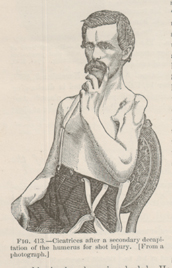Title: Waldron, C. A.
Source text: The Medical and Surgical History of the War of the Rebellion. (1861-65.), Part 2, Volume 2 (Washington, DC: Government Printing Office, 1876), 544.
Civil War Washington ID: med.d2e31026
TEI/XML: med.d2e31026.xml
CASE 1514.—Lieutenant C. A. Waldron, Co. B, 20th Rhode Island, age 24 years, was wounded in the left shoulder at the Wilderness, May 6, 1864. This officer was treated in the Seminary Hospital, Georgetown, and subsequently in private quarters in Washington, and received a leave of absence, at the termination of which he was mustered out, June 17, 1864. Examiner C. G. McKnight, of Providence, reported, November 4, 1864: "Wounded in the left shoulder, the bone being shattered badly. The wound is still open and discharging; the arm is entirely useless." On April 1, 1868, Dr. H. W. Rivers, late surgeon 4th Rhode Island, who treated this officer after his discharge, reported: "From the time of his being wounded he had very little treatment until he came under my charge. Pieces of bone continued to come away from time to time; several sinuses formed about the shoulder, and a constant fœtid discharge was kept up. Mr. Waldron came under my notice about the first of September, 1867, and, after a careful examination of the parts, I advised him to have the head of the humerus excised. At this time, he was very much emaciated and run down. On September 27th, his general health having been improved by tonics and good diet, he presented himself for the operation. Assisted by Surgeons G. W. Carr, late of the 2d Rhode Island, and R. Miller, late of the 4th Rhode Island, and in presence of Dr. W. H. Hazard, of Wakefield, the patient being thoroughly under the influence of sulphuric ether, a V-shaped incision was made including the whole of the deltoid muscle. The flap thus made being dissected up, showed the head and upper portion of the humerus in a very carious condition. Several pieces, including the portion of the head not destroyed by caries, were detached and removed. The shaft was then sawn through and detached. A few pieces of carious bone were then removed by the gouge, and the parts brought together with six points of interrupted sutures. The wound was dressed with compresses wet with water, half a grain of morphia administered, and the patient put to bed. On September 28th, a solution of permanganate of potash was substituted for the water dressing. On October 3d, the patient was doing well, and from this date he continued to improve, the wound uniting almost by the first intention in three weeks from the date of operation. On March 20, 1868, he came to Providence to be photographed. His arm was found to be in a very useful condition, the wound having been long since healed. He was able to carry his hand to his mouth, tie his cravat, and to grasp with considerable power. His general health had improved, and he had gained fifteen pounds in weight since last October. The accompanying photographs show the result of the operation and the pieces of bone removed." The photographs are copied in the annexed wood-cuts (FIGS. 413 and 414). In December, 1871, Mr. Waldron was examined by a Board, who reported that his arm was useless from injuries to the muscles and nerves. His pension was paid March 4, 1874.

